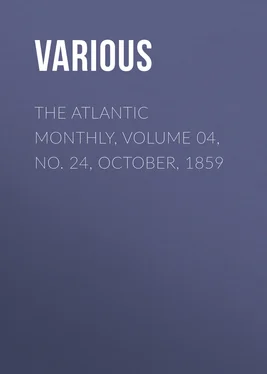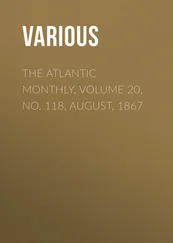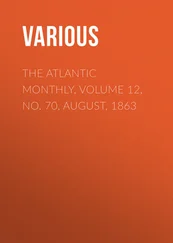Various - The Atlantic Monthly, Volume 04, No. 24, October, 1859
Здесь есть возможность читать онлайн «Various - The Atlantic Monthly, Volume 04, No. 24, October, 1859» — ознакомительный отрывок электронной книги совершенно бесплатно, а после прочтения отрывка купить полную версию. В некоторых случаях можно слушать аудио, скачать через торрент в формате fb2 и присутствует краткое содержание. Жанр: foreign_antique, periodic, foreign_edu, на английском языке. Описание произведения, (предисловие) а так же отзывы посетителей доступны на портале библиотеки ЛибКат.
- Название:The Atlantic Monthly, Volume 04, No. 24, October, 1859
- Автор:
- Жанр:
- Год:неизвестен
- ISBN:нет данных
- Рейтинг книги:5 / 5. Голосов: 1
-
Избранное:Добавить в избранное
- Отзывы:
-
Ваша оценка:
- 100
- 1
- 2
- 3
- 4
- 5
The Atlantic Monthly, Volume 04, No. 24, October, 1859: краткое содержание, описание и аннотация
Предлагаем к чтению аннотацию, описание, краткое содержание или предисловие (зависит от того, что написал сам автор книги «The Atlantic Monthly, Volume 04, No. 24, October, 1859»). Если вы не нашли необходимую информацию о книге — напишите в комментариях, мы постараемся отыскать её.
The Atlantic Monthly, Volume 04, No. 24, October, 1859 — читать онлайн ознакомительный отрывок
Ниже представлен текст книги, разбитый по страницам. Система сохранения места последней прочитанной страницы, позволяет с удобством читать онлайн бесплатно книгу «The Atlantic Monthly, Volume 04, No. 24, October, 1859», без необходимости каждый раз заново искать на чём Вы остановились. Поставьте закладку, и сможете в любой момент перейти на страницу, на которой закончили чтение.
Интервал:
Закладка:
Next to convenience is fitness to years and condition in life. A man can as soon, by taking thought, add a cubit to his stature as a woman take five years from her appearance by "dressing young." The attempt to make age look like youth only succeeds in depriving age of its peculiar and becoming beauty, and leaving it a bloated or a haggard sham.—Conditions of life have no political recognition, with us, yet they none the less exist. They are not higher and lower; they are different. The distinction between them is none the less real, that it is not written down, and they are not labelled. Reason and taste alike require that this difference should have outward expression. The abandonment of distinctive professional costume is associated with a movement of social progress, and so cannot be arrested; but it is much to be deplored in its effect upon the beauty, the keeping, and the harmonious contrast of external life.
Of the absolute beauty of dress form is the most important element, as it is of all arts which appeal to the eye. The lines of costume should, in every part, conform to those of Nature, or be in harmony with them. "Papa," said a little boy, who saw his father for the first time in complete walking-costume, "what a high hat! Does your head go up to the top of it?" The question touched the cardinal point of form in costume. Unbroken, flowing lines are essential to the beauty of dress; and fixed angles are monstrous, except where Nature has placed them, at the junction of the limbs with the trunk. The general outlines of the figure should be indicated; and no long garment which flows from the shoulders downward is complete without a girdle. 2 2 Mr. Grey [ in parenthesis, and by way of illustration ]. The fashion for ladies' full dress during several years, and but recently abandoned, with its straight line cutting pitilessly across the rounded forms of the shoulders and bust, and making women seem painfully squeezed upward out of their gowns,—its berthe , concealing both the union of the arms with the trunk and the flowing lines of that part of the person, and adding another discordant straight line (its lower edge) to the costume,—its long, ungirdled waist, wrought into peaks before and behind, and its gathered swell below, is an instance in point, of utter disregard of Nature and deliberate violation of harmony, and the consequent attainment of discord and absurdity in every particular. It is rivalled only by the dress-coat, which, with quite unimportant variations, has been worn by gentlemen for fifty years. The collar of this, when stiff and high, quite equals the berthe in absurdity and ugliness; and the useless skirt is the converse in monstrosity to the hooped petticoat.
As to distinctive forms of costume for the sexes, long robes, concealing the person from the waist to considerably below the knee, are required by the female figure, if only to veil certain inherent defects,—if those peculiarities may be called defects, which adapt it to its proper functions and do not diminish its sexual attractiveness. Woman's figure having its centre of gravity low, its breadth at the hip great, and, from the smallness of her feet, its base narrow, her natural movement in a costume which does not conceal the action of the hip and knee-joints is unavoidably awkward, though none the less attractive to the eye of the other sex. 3 3 For instance, the movements of ballet-dancers, except the very artificial ones of the feet and hands.
In color, the point of next importance, no fine effects of costume are to be attained without broad masses of pure and positive tints. These, however, may be enlivened with condimental garniture of broken and combined colors. But dresses striped, or, yet worse, plaided or checkered, are atrocious violations of good taste; indeed, party-colored costumes are worthy only of the fools and harlequins to whose official habits they were once set apart. The three primary, and the three secondary colors, red, yellow, and blue, orange, green, and purple, (though not in their highest intensity,) afford the best hues for costume, and are inexhaustible in their beautiful combinations. White and black have, in themselves, no costumal character; but they may be effectively used in combination with other colors. The various tints of so-called brown, that we find in Nature, may be employed with fine effect; but other colors, curiously sought out and without distinctive hue, have little beauty in themselves; and any richness of appearance which they may present is almost always due to the fabric to which they are imparted. Colors have harmonies and discords, like sounds, which must be carefully observed in composing a costume. Perception of these cannot be taught, more than perception of harmony in music; but, if possessed, it may be cultivated.
Extrinsic ornament or trimming should be avoided, except to indicate completeness, as at a hem,—or to blend forms and colors, as soft lace at the throat or wrists. The essential beauty of costume is in its fitness, form, and color; and the effect of this beauty may be entirely frittered away by trimmings. These, however costly, are in themselves mere petty accessories to dress; and the use of them, except to define its chief terminal outlines, or soften their infringement upon the flesh, is a confession of weakness in the main points of the costume, and an indication of a depraved and trivial taste. When used, they should have beauty in themselves, which is attainable only by a clearly marked design. Thus, the exquisite delicacy of fabric in some kinds of lace does not compensate for the blotchy confusion of the shapeless flower-patterns worked upon it. Not that lace or any other ornamental fabric should imitate exactly the forms of flowers or other natural objects, but that the conventional forms should be beautiful in themselves and clearly traced in the pattern.—Akin to trimmings are all other appendages to dress,—jewels, or humbler articles; and as every part of dress should have a function, and fulfil it, and seem to do so, and should not seem to do that which it does not, these should never be worn unless they serve a useful purpose,—as a brooch, a button, a chain, a signet or guard ring,—or have significance,—as a wedding-ring, an epaulet, or an order. 4 4 Thus, it is the office of a bonnet or a hat to protect the head and face; and so a sun-shade carried by the wearer of a bonnet is a confession that the bonnet is a worthless thing, worn only for show: but an umbrella is no such confession; because it is not the office of the hat or bonnet to shelter the whole person from sun or rain.
But the brooch and the button must fasten, the chain suspend, the ring bear a device, or they sink into pretentious, vulgar shams. And there must be keeping between these articles and their offices. To use, for instance, a massive golden, or, worse, gilded chain to support a cheap silver watch is to reverse the order of reason and good taste.
The human head is the most beautiful object in Nature. It needs a covering at certain times; but to decorate it is superfluous; and any decoration, whether of flowers, or jewels, or the hair itself, that distorts its form or is in discord with its outlines, is an abomination.
Perfumes are hardly a part of dress; yet, as an addition to it often made, they merit censure, with slight exception, as deliberate contrivances to attract attention to the person, by appealing to the lowest and most sensuous of the senses. Next to no perfume at all, a faint odor of roses, or of lavender, obtained by scattering the leaves of those plants in clothes-presses, or of the very best Cologne-water, is most pleasant.
In its general expression, dress should be cheerful and enlivening, but, at least in the case of adults, not inconsistent with thoughtful earnestness. There is a radical and absurd incongruity between the real condition and the outward seeming of a man or woman who knows what life is, and purposes to discharge its duties, enjoy its joys, and bear its sorrows, and who is clad in a trivial, grotesque, or extravagant costume.—These, then, are the elementary requisites of dress: that it be comfortable and decent, convenient and suitable, beautiful in form and color, simple, genuine, harmonious with Nature and itself.
Читать дальшеИнтервал:
Закладка:
Похожие книги на «The Atlantic Monthly, Volume 04, No. 24, October, 1859»
Представляем Вашему вниманию похожие книги на «The Atlantic Monthly, Volume 04, No. 24, October, 1859» списком для выбора. Мы отобрали схожую по названию и смыслу литературу в надежде предоставить читателям больше вариантов отыскать новые, интересные, ещё непрочитанные произведения.
Обсуждение, отзывы о книге «The Atlantic Monthly, Volume 04, No. 24, October, 1859» и просто собственные мнения читателей. Оставьте ваши комментарии, напишите, что Вы думаете о произведении, его смысле или главных героях. Укажите что конкретно понравилось, а что нет, и почему Вы так считаете.












